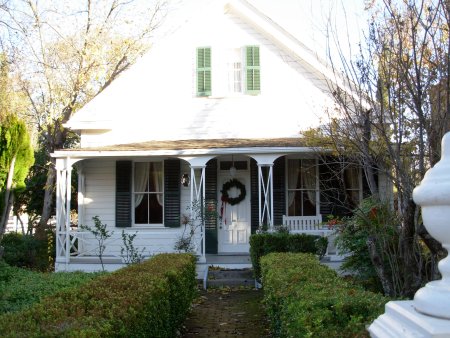Sunset Limited. Hiawatha. Empire Builder. Super Chief. I can’t hear the names of the great American train lines without finding myself completely smitten. The Romance of the Rails has gotten to me pretty much every time I’ve taken a train, even a lowly commute one. My first long-distance trip was on the Coast Starlight, a two-night journey (was it supposed to be one? I didn’t care) from San Francisco to Seattle. My daughter and I boarded about midnight, when many of the passengers were already asleep. We were given warm chocolate chip cookies as we tiptoed to our sleeping car. I stayed up most of the night, staring out the train window at the houses and yards as they passed by in slices, under a full moon, at just the right speed for contemplation. The train’s mournful whistle occasionally sounded onto the empty main streets. At rural stops, a passenger or two would come aboard, their drivers shuffling back to their hulking cars.

In the morning, we ate on a table set with a white tablecloth, as the train circled a snow-covered Mt. Shasta. We’d later play games in the observation car, meet Europeans who talked politics and American father-son pairs touring the country’s ball parks, drink wine with a very knowledgeable and funny sommelier, watch movies in a beautiful, lower-level movie screening car, and continue staring out the window at the tiny logging towns, the green college towns, the gorge-filled Willamette Valley, and the fir-lined Cascade Mountains. We may have been a full day late getting into Seattle but, of course, we couldn’t have been happier.


Richard Talmy, the sommelier, was indeed a trip highlight. He was encyclopedic about California wines and wine tasting, as well as train and Coast Starlight history, and he served all up with a great deal of verve, encouraging everyone to eat and drink up, to have fun, and to just acknowledge the fact that we’d “get on the train as passengers and leave as freight.”
Train Web writer and photographer Carl Morrison wrote a piece on parlor car wine tasting with Richard Talmy, where you can see the man in action and get a bit of the flavor of a tasting.

I’ve learned since that first trip that the Coast Starlight is the only Amtrak route to feature a parlor car with wine tasting and a screening room. (And that the parlor car itself is a refurbished car from the historic El Capitan line of the Atchison, Topeka and Santa Fe.) Even so, last summer I had the pleasure of taking the Washington D.C. – New York train (which bore the unromantic name, Acela) and, truly, just a window seat and a garden burger were enough to make my day. Dusk and sunset didn’t hurt the mood, either, as I took in every aluminum-sided diner (themselves former train cars), corner tavern, brick row house, backyard swing set, hilly main street, church steeple, and pane-windowed factory building as the train swung through Delaware, Pennsylvania, and New Jersey, and finally to its resting place in a tunnel beneath Penn Station. Only the vaulted Grand Central lobby would have made the trip more complete. I could have come with this placard of warning: Beware romantic, yearning West Coast person experiencing train rapture.

Our car attendant on that first trip was named Douglas and, like Richard, he seems to be a character of lore among Coast Starlight riders. From the cookie on, we knew we were in good hands. A big man, I’ll never forget him cruising through the dining car, about mid-morning, calling out “Hungry Man Walking.” His humor (and our laughter) continued the whole trip.
We slept in a “roomette”, really a closet with beds that hinged out from the walls. (I’ve since booked a family sleeping car, which is roomy and sleeps four, but sacrifices views.) What we didn’t have, apparently, was the grand-era Pullman sleeper car service and room. While George Pullman didn’t invent the sleeper car, it was he who realized there was a market in luxury, comfort and service, and he and his Pullman cars dominated the industry during its golden age, when everyone traveled by train. A key component of Pullman service was the Pullman porter. The porters were black men — the first ones were former slaves — and it is said that, even though some of the work could be demeaning, Pullman provided them with almost unequaled earning opportunity and job security for the times. During World War II, there were 12,000 Pullman porters. Their union was referred to as a Brotherhood. It’s shocking, then, that the last Pullman car would take a run on December 31, 1968, a victim of the plane and the car.

Supreme Court justice Thurgood Marshall, former San Francisco mayor Willie Brown, and Olympic athlete Wilma Rudolph are just three famous offspring of Pullman porters.The last Pullman porters, many of whom are in their 80s and 90s, are gathered for last year’s Train Day celebration at Philadelphia’s 30th Street Station.
National Train Day commemorates the “golden spike” that was driven into the final tie that joined the Central Pacific and the Union Pacific railways, thus creating America’s first transcontinental railroad, on May 10, 1869. I salute Train Day, the Pullman porters and the grand era of rail travel, even if it comes in the form of a refurbished Parlor Car.
Washington D.C., Philadelphia, New York, Chicago, and Los Angeles are among the nearly 200 cities celebrating National Train Day with events, entertainment and exhibits at their train stations. Visit the National Train Day web site for complete event information and other resources about train history,
I suggest this site to get lost in some wonderful train sounds: dieselairhorns.com/sounds.


Pullman Photo Courtesy of A. Philip Randolph Pullman Porter Museum
Early 1900s: Waiter John Larvell Dorsey, left, on Baltimore & Ohio Railroad.






























































































